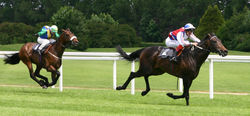
Modern thoroughbred racing involves a science dilemma. The horses are bred for extreme speed, and a primary goal of this breeding has been to decrease bone mass while raising muscle mass, as a horse "carrying" a light skeleton using abnormally strong muscles will travel faster at a gallop than one with a heavier bone load. As a result, modern thoroughbreds are muscularly powerful but osteologically delicate creatures. Three out of every 2000 races result in a career-ending injury to one or more racers, typically due to broken leg bones; a ratio far in excess of almost all other human and animal sports. Of those injuries, more than 60% result in the horse being euthanized. Leg injuries, though not immediately fatal, are life-threatening because a horse's weight must be distributed evenly on all four legs to prevent circulatory problems, laminitis and other infections. If a horse loses the use of one leg, it cannot function; its other legs will quickly break down as well, leading to a slow death.
In the wake of the 2006 Preakness Stakes, in which Kentucky Derby winner Barbaro sustained severe fractures, there were signs that animal rights groups intended to target the thoroughbred racing industry. The bioethics are seldom clean-cut, however. While thoroughbreds are delicate and horse racing is hazardous, veterinary science is also developing, so that previously hopeless cases (such as Barbaro's) can now be treated successfully. Thoroughbreds are arguably [citation needed] as much helped as harmed by the racing industry, with the research in veterinary medicine, largely funded and driven by the industry.
Mumbai 5-4-15
10 years ago



No comments:
Post a Comment